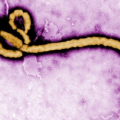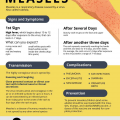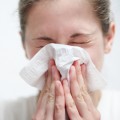According to the World Health Organization, Coronaviruses (CoV) are a large family of viruses that cause illnesses ranging from the common cold to more severe diseases. It is not the first time that a coronavirus is associated with a severe form of flu that would make headlines due to its widespread effect in different countries. Coronaviruses are zoonotic, this means, the virus is passed on from animals to humans.
The Severe Acute Respiratory Syndrome (SARS-CoV) resulted in an epidemic in 2003 affecting 8000 patients in 26 countries. Until now, it has not been confirmed how it started but bats are thought to have been the animal reservoir and it was eventually transmitted by civet cats to humans. The first cases were reported in Guangdong China. Fortunately, SARS was contained and the last case was reported in July of 2003.
The Middle East Respiratory Syndrome (MERS-CoV) is also a coronavirus infection. First identified in Saudi Arabia in 2012, MERS-Cov is thought to have been transmitted from camels. Symptoms included fever, cough, shortness of breath as well as diarrhea. 35% of the patients who were infected died.
And now, there is the 2019 Novel Coronavirus (NCoV), recently renamed COVID-19.
What do we know about NCov so far?
As reported by the World Health Organization, the first cases of pneumonia of unknown etiology were reported on 31 December 2019 in Wuhan City, Hubei Province of China. On January 7, 2020, it was identified that the causative agent is the novel coronavirus (NCoV).
As of now, it has been speculated that since coronaviruses are zoonotic infections, meaning it is transmitted from animals to humans and eventually human to human, NCoV is believed to have come from bats or other wild animals in the wet market in Wuhan.
In light of available evidence and past experience, WHO makes the following general recommendations:
- As a general precaution, anyone visiting live animal markets, wet markets or animal product markets, should practice general hygiene measures, including regular handwashing with soap and potable water after touching animals and animal products, avoiding touching eyes, nose or mouth with hands, and avoiding contact with sick animals or spoiled animal products. Any contact with other animals possibly living in the market (e.g., stray cats and dogs, rodents, birds, bats) should be strictly avoided. Attention should also be taken to avoid contact with potentially contaminated animal waste or fluids on the soil or structures of shops and market facilities.
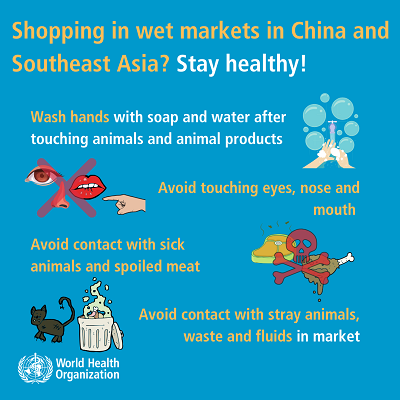
- The consumption of raw or undercooked animal products should be avoided. Raw meat, milk or animal organs should be handled with care, to avoid cross-contamination with uncooked foods, as per good food safety practices.
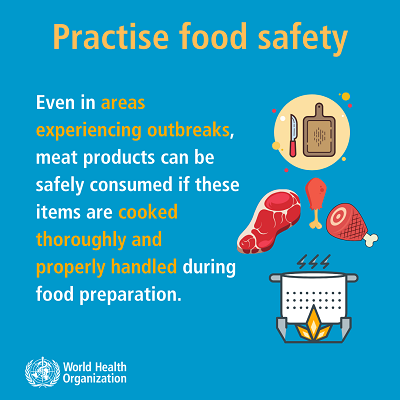
How is the disease transmitted?
Viruses can be spread in several ways. According to the Centers for Disease Control (CDC), flu viruses are spread mainly by droplets made when people with flu cough, sneeze or talk.
Droplet transmission occurs when bacteria or viruses travel on relatively large respiratory droplets when people sneeze or cough. These droplets are loaded with bacteria or viruses. Since these droplets are relatively heavier than the air, they are only in the air for 3 feet then they settle to the ground. So if an infected person coughs, the most at-risk individuals will be the people within 3 feet.
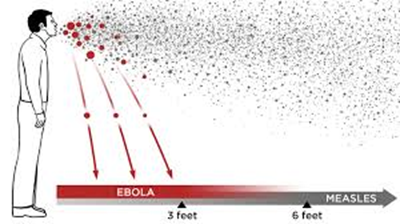
For illustration purposes. This is how far droplets loaded with virus or bacteria go when an infected person coughs or sneezes.
Coronaviruses, in particular, are believed to be spread by droplet transmission.
What happens next after inhaling the virus?
After inhalation of droplets from an infected person or inhaling the virus you get from touching infected surfaces, the virus attaches to the cell lining of the nose and throat, rapidly reproduce and invade the cells to go into the blood and result to infection.
Nature of the disease
Symptoms are influenza-like and include fever, malaise, myalgia, headache, diarrhea, and shivering. No individual symptom or cluster of symptoms has proved to be specific for a diagnosis of COVID-19.
Cough can be dry or productive of sputum, there can also be shortness of breath, and diarrhea. Severe cases often evolve rapidly, progressing to respiratory distress and requiring intensive care. Those who have rapidly progressive course are usually the patients with a pre-existing medical condition or those with a weak immune system.
How do we prevent getting infected with COVID-19?
Proper hygiene is very important. Since viruses thrive on surfaces of objects, it is very important to wash your hands frequently. Washing with soap and water is a very effective way to get rid of the virus in your hands. Alcohol is only advised if soap and water are not available. If your hands are soiled, washing with soap and water is also the recommendation.
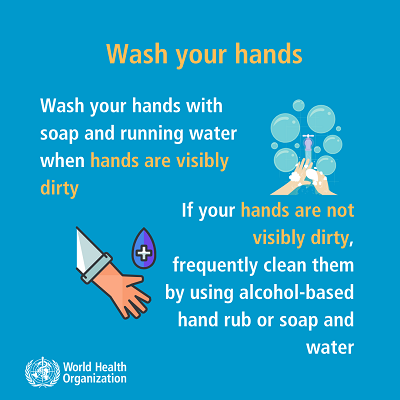 Do not touch your face, nose, and mouth or the face of others. If you must, wash your hands first.
Do not touch your face, nose, and mouth or the face of others. If you must, wash your hands first.
Cough etiquette is equally important. Not everyone who coughs or sneezes has coronavirus but they might transmit other viruses that would also cause flu. Remember that the viruses can travel 3 feet from the person who sneezes or coughs so avoid going to crowded places because you just don’t know if the person beside you is sick or will suddenly sneeze or cough. On the other hand, if you are the person with flu, make an effort not to infect others. Cover your mouth when you cough, wash your hands often, throw tissues immediately directly to the trash bin, and wear surgical face masks if available.
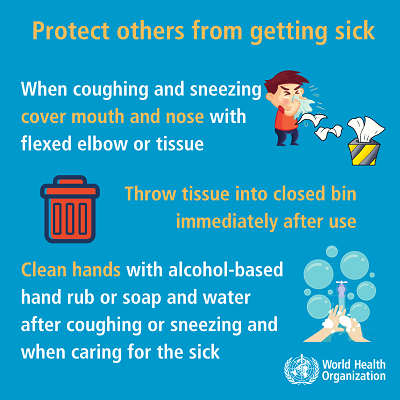 Standard recommendations also include thoroughly cooking food especially meat and eggs.
Standard recommendations also include thoroughly cooking food especially meat and eggs.
Most importantly, avoid close contact with anyone showing symptoms of respiratory illness such as coughing and sneezing.
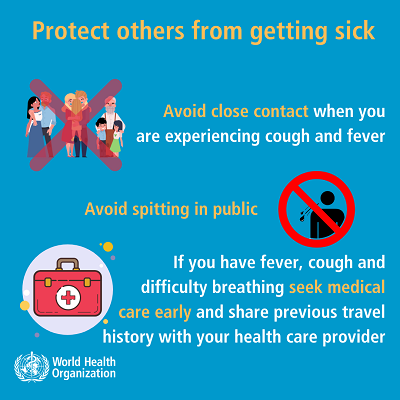
Is wearing a mask really needed?
The recent reports caused panic and resulted in the scarcity of face masks, be it surgical masks, N95 masks or reusable cloth masks in the market. The big question is, is it really needed? The consensus is to use a surgical mask if you are going to crowded places, will be exposed to sick people or if you have cough, colds or respiratory symptoms. Otherwise face masks are not really needed. An N-95 mask is mainly indicated in hospital settings or if there is a community outbreak. Cloth mask is not a guaranteed barrier to droplet transmission from people who are sick but would probably decrease the chances of inhaling the droplets if face masks are not available.
Can a person without flu symptoms transmit the infection?
As of this point, since there are only limited data about COVID-19, we don’t know for sure if once can be an asymptomatic carrier or if there is indeed asymptomatic transmission. Asymptomatic transmission means that a person who does not exhibit symptoms such as cough, colds, or fever can infect others. The possibility of asymptomatic transmission was first reported in Germany when a Chinese lady who went there became the source of the COVID-19. The report said that the Chinese lady, who was not sick at that time, ended up transmitting the disease with 2 other people she interacted within Germany. When she returned to China, she then showed symptoms of the disease and was quarantined. Further investigation revealed that the Chinese lady was already sick when she was in Germany, hence the transmission, debunking the possibility of asymptomatic transmission. So until another case surfaces, for now, asymptomatic transmission is unlikely.
Additional precautionary measures are recommended in high-risk groups. High-risk individuals are those with other illnesses such as diabetes, heart disease, cancer, etc. as well as workers who handle animals and workers in slaughterhouses.
How is COVID-19 treated?
As of now, there is no specific treatment for COVID-19. Antivirals that are available in the market are not indicated for COVID-19. If you have symptoms, it is advised that you seek consult with a proper healthcare provider so you can be evaluated and managed properly.
For the latest information on the new coronavirus, visit the 2019-nCoV page of WHO.


 (10 votes, average: 4.60 out of 5)
(10 votes, average: 4.60 out of 5)






